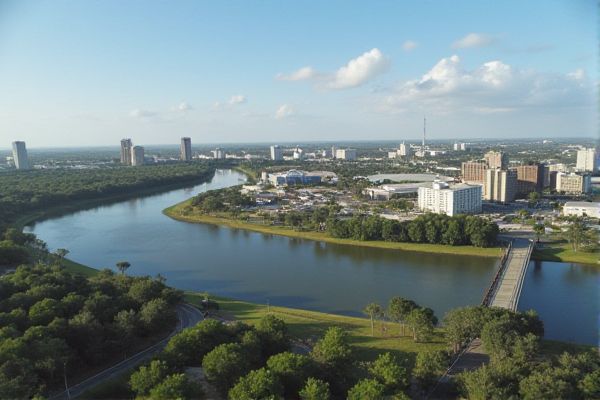
Transportation and commuting in Louisiana: Public bus and streetcar options in major cities. Louisiana DOTD oversees highway maintenance. Traffic congestion common in urban areas. Car ownership essential for rural areas. Ride-sharing services available statewide. Bike-friendly paths in select regions. Ferry services along Mississippi River. Affordable gas prices compared to national average. Amtrak stations in New Orleans and Lafayette. Seasonal road closures due to hurricanes.
Public bus and streetcar options in major cities.
In New Orleans, the New Orleans Regional Transit Authority (RTA) operates an extensive network of public buses and streetcars. The system includes five streetcar lines: St. Charles Avenue, Loyola-Riverfront, Canal Street, Canal-Cemeteries, and Rampart-St. Claude, alongside numerous bus routes. With recent upgrades like the New Links Network, the RTA is focused on improving access, reducing wait times, and enhancing connectivity across the city.
Louisiana DOTD oversees highway maintenance.
The Louisiana Department of Transportation and Development (DOTD) oversees the maintenance of virtually all access-controlled roadways in Louisiana, including an extensive network of state-maintained highways and bridges. Their primary focus is on ensuring safety, mobility, and pavement condition through various management strategies and infrastructure investments. For more detailed insights into their initiatives and plans, you can explore the 2015 Statewide Transportation Plan, which offers comprehensive information about transportation infrastructure in Louisiana.
Traffic congestion common in urban areas.
Traffic congestion in Louisiana, particularly in urban areas like Baton Rouge, is severe, with Baton Rouge ranked as having the fourth-worst traffic congestion in the U.S., resulting in significant delays and increased costs for commuters. This issue is largely due to a lack of infrastructure investment, population growth, and limited public transportation options. For more information on this pressing issue, visit the detailed analysis on Baton Rouge Traffic, and explore potential solutions and factors contributing to this challenge.
Car ownership essential for rural areas.
Car ownership remains essential for rural areas in Louisiana, as public transportation options are limited, and cars are often the only viable means of travel between peripheral areas. This highlights the ongoing need for car use in regions where alternative transport modes are scarce. For more insight into this dependency, the Reversing Car Dependency document provides an in-depth look at the challenges and potential solutions for reducing reliance on cars in similar regions.
Ride-sharing services available statewide.
Ride-sharing services, including Uber and Lyft, are available statewide in Louisiana, providing citizens and visitors with additional transportation options and helping to connect smaller and rural communities. For more information about ride-sharing and to discover how these services integrate with local transit networks, you can visit the Louisiana Department of Transportation and Development's RideShare page.
Bike-friendly paths in select regions.
Louisiana offers several bike-friendly paths, including the Mississippi River Trail in New Orleans, the Tammany Trace from Covington to Slidell, the Lafitte Greenway in New Orleans, and the Baton Rouge Levee Bike Path, each providing unique cycling experiences with amenities like lighting, seating, and access to local attractions and public spaces. These trails cater to cyclists of all experience levels and interests, showcasing the state's diverse cycling infrastructure. For more information on these exciting trails, visit the Best Places to Cycle in Louisiana, where you can discover some of the best routes to explore.
Ferry services along Mississippi River.
Ferry services along the Mississippi River in Louisiana include several routes, such as the Algiers/Canal Street, Lower Algiers/Chalmette, and Plaquemine ferries, which are operated by various entities including the New Orleans RTA and LabMar Ferry Services. The ferries have specific schedules, capacities, and tolls, with some routes offering 24-hour service and others operating on limited hours due to staffing or maintenance issues. For detailed and current information on these routes, you can visit the Ferry Status page, which regularly updates the operational status and schedule adjustments of these vital transportation links.
Affordable gas prices compared to national average.
Louisiana typically has lower gas prices compared to the national average due to its extensive oil refining capabilities, which reduce transportation costs and keep prices lower than in states further away from refineries. To learn more about this trend, you can visit the article on Lower Gas Prices in Louisiana. Its strategic position near numerous refining facilities ensures that consumers enjoy more affordable fuel compared to other regions across the nation.
Amtrak stations in New Orleans and Lafayette.
In Louisiana, the New Orleans Amtrak Station, known as the Union Passenger Terminal (NOL), is a major hub serving three Amtrak trains: the Sunset Limited, City of New Orleans, and Crescent. The Lafayette Amtrak Station (LFT), restored in 2007, is served by the Sunset Limited and offers amenities such as wheelchair accessibility, food service, and parking, while also housing a city transit office and waiting room for bus and Amtrak passengers.
Seasonal road closures due to hurricanes.
Seasonal road closures in Louisiana due to hurricanes like Francine result from rising water, storm damage, and the closure of floodgates and movable bridges, with numerous state routes and local roads affected across various parishes. This includes closures due to high water, downed trees, and power lines. For detailed information and updates, tracking resources like the Coastal Desk at WWNO can be invaluable in navigating these challenges and staying informed about any changes in infrastructure status, ensuring safer travel during these disruptive times.
